Marketing Intelligence Report: Sainsbury, Buyer Behavior, Research
VerifiedAdded on 2019/12/03
|22
|5567
|233
Report
AI Summary
This report delves into the realm of marketing intelligence, focusing on buyer behavior and the purchase decision-making process. It explores various theories related to individual and market behavior, along with the factors influencing consumer choices. The report then transitions to market research techniques, evaluating different methods and outlining a plan to gather information on customer satisfaction, specifically for Sainsbury's. It includes the design and analysis of a customer satisfaction survey, as well as an assessment of the validity and reliability of the research findings. Furthermore, the report assesses market size trends and conducts a competitive analysis, evaluating opportunities and threats for the brand. The report provides a comprehensive overview of marketing principles and their practical application within a business context.
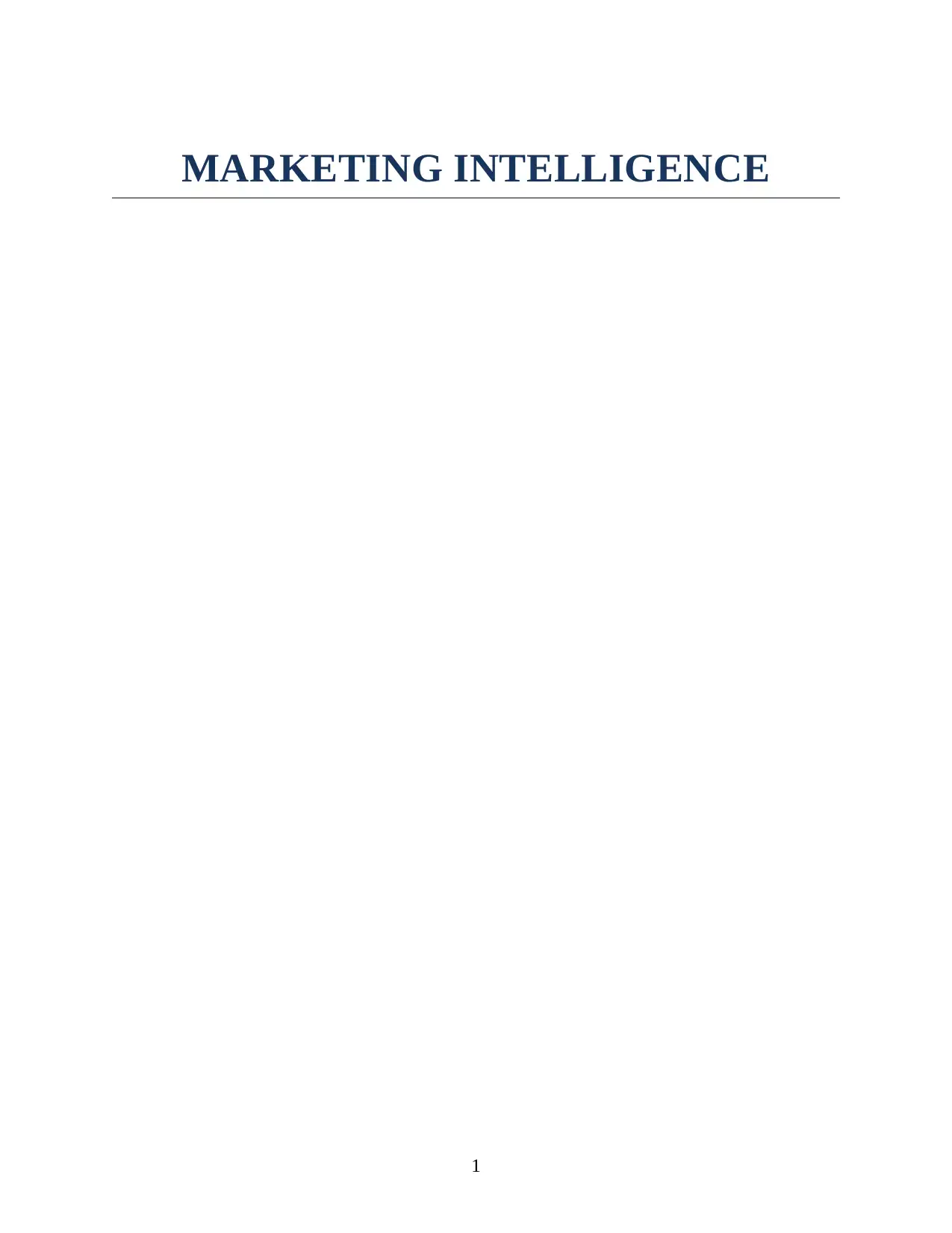
MARKETING INTELLIGENCE
1
1
Paraphrase This Document
Need a fresh take? Get an instant paraphrase of this document with our AI Paraphraser
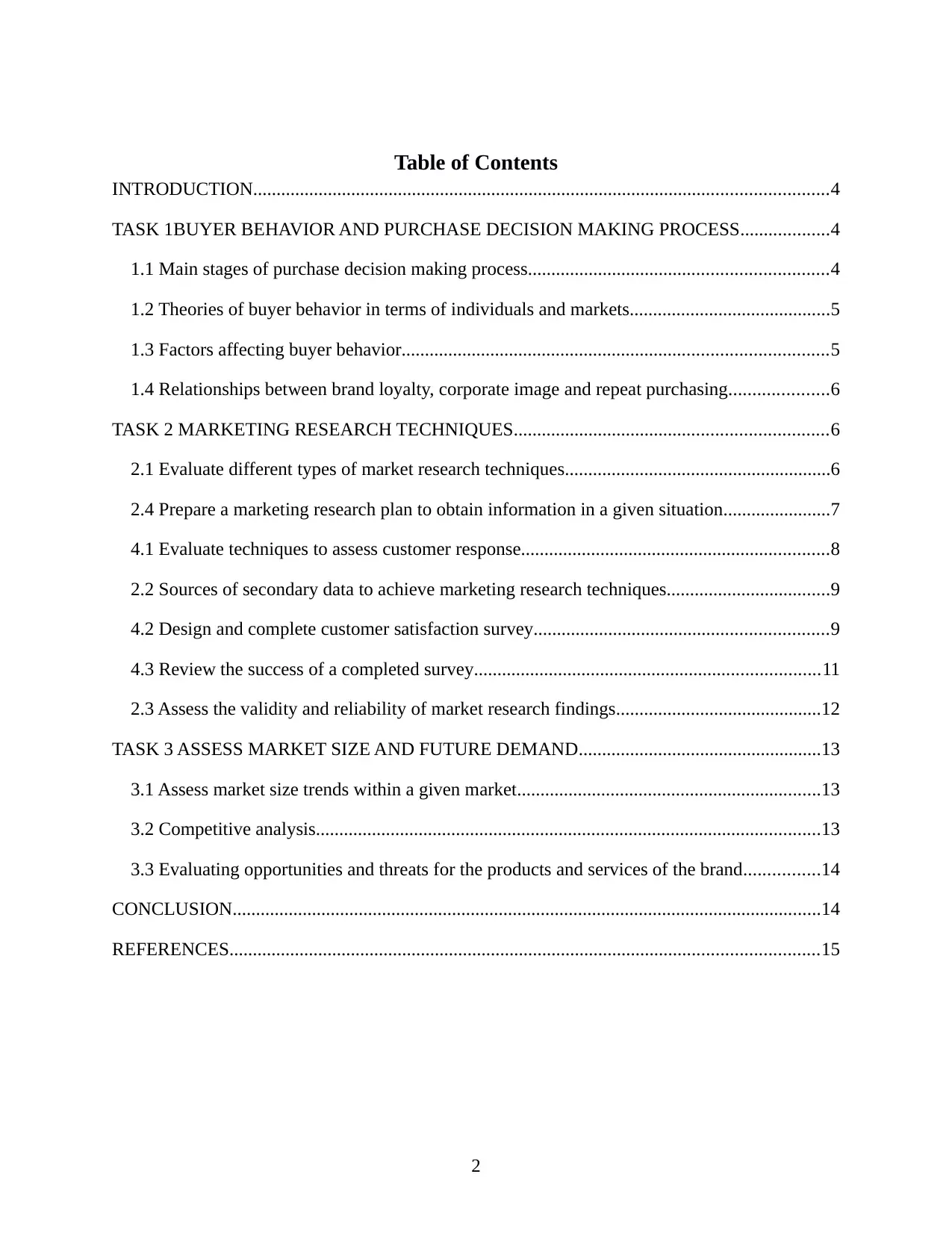
Table of Contents
INTRODUCTION...........................................................................................................................4
TASK 1BUYER BEHAVIOR AND PURCHASE DECISION MAKING PROCESS...................4
1.1 Main stages of purchase decision making process................................................................4
1.2 Theories of buyer behavior in terms of individuals and markets...........................................5
1.3 Factors affecting buyer behavior...........................................................................................5
1.4 Relationships between brand loyalty, corporate image and repeat purchasing.....................6
TASK 2 MARKETING RESEARCH TECHNIQUES...................................................................6
2.1 Evaluate different types of market research techniques.........................................................6
2.4 Prepare a marketing research plan to obtain information in a given situation.......................7
4.1 Evaluate techniques to assess customer response..................................................................8
2.2 Sources of secondary data to achieve marketing research techniques...................................9
4.2 Design and complete customer satisfaction survey...............................................................9
4.3 Review the success of a completed survey..........................................................................11
2.3 Assess the validity and reliability of market research findings............................................12
TASK 3 ASSESS MARKET SIZE AND FUTURE DEMAND....................................................13
3.1 Assess market size trends within a given market.................................................................13
3.2 Competitive analysis............................................................................................................13
3.3 Evaluating opportunities and threats for the products and services of the brand................14
CONCLUSION..............................................................................................................................14
REFERENCES..............................................................................................................................15
2
INTRODUCTION...........................................................................................................................4
TASK 1BUYER BEHAVIOR AND PURCHASE DECISION MAKING PROCESS...................4
1.1 Main stages of purchase decision making process................................................................4
1.2 Theories of buyer behavior in terms of individuals and markets...........................................5
1.3 Factors affecting buyer behavior...........................................................................................5
1.4 Relationships between brand loyalty, corporate image and repeat purchasing.....................6
TASK 2 MARKETING RESEARCH TECHNIQUES...................................................................6
2.1 Evaluate different types of market research techniques.........................................................6
2.4 Prepare a marketing research plan to obtain information in a given situation.......................7
4.1 Evaluate techniques to assess customer response..................................................................8
2.2 Sources of secondary data to achieve marketing research techniques...................................9
4.2 Design and complete customer satisfaction survey...............................................................9
4.3 Review the success of a completed survey..........................................................................11
2.3 Assess the validity and reliability of market research findings............................................12
TASK 3 ASSESS MARKET SIZE AND FUTURE DEMAND....................................................13
3.1 Assess market size trends within a given market.................................................................13
3.2 Competitive analysis............................................................................................................13
3.3 Evaluating opportunities and threats for the products and services of the brand................14
CONCLUSION..............................................................................................................................14
REFERENCES..............................................................................................................................15
2
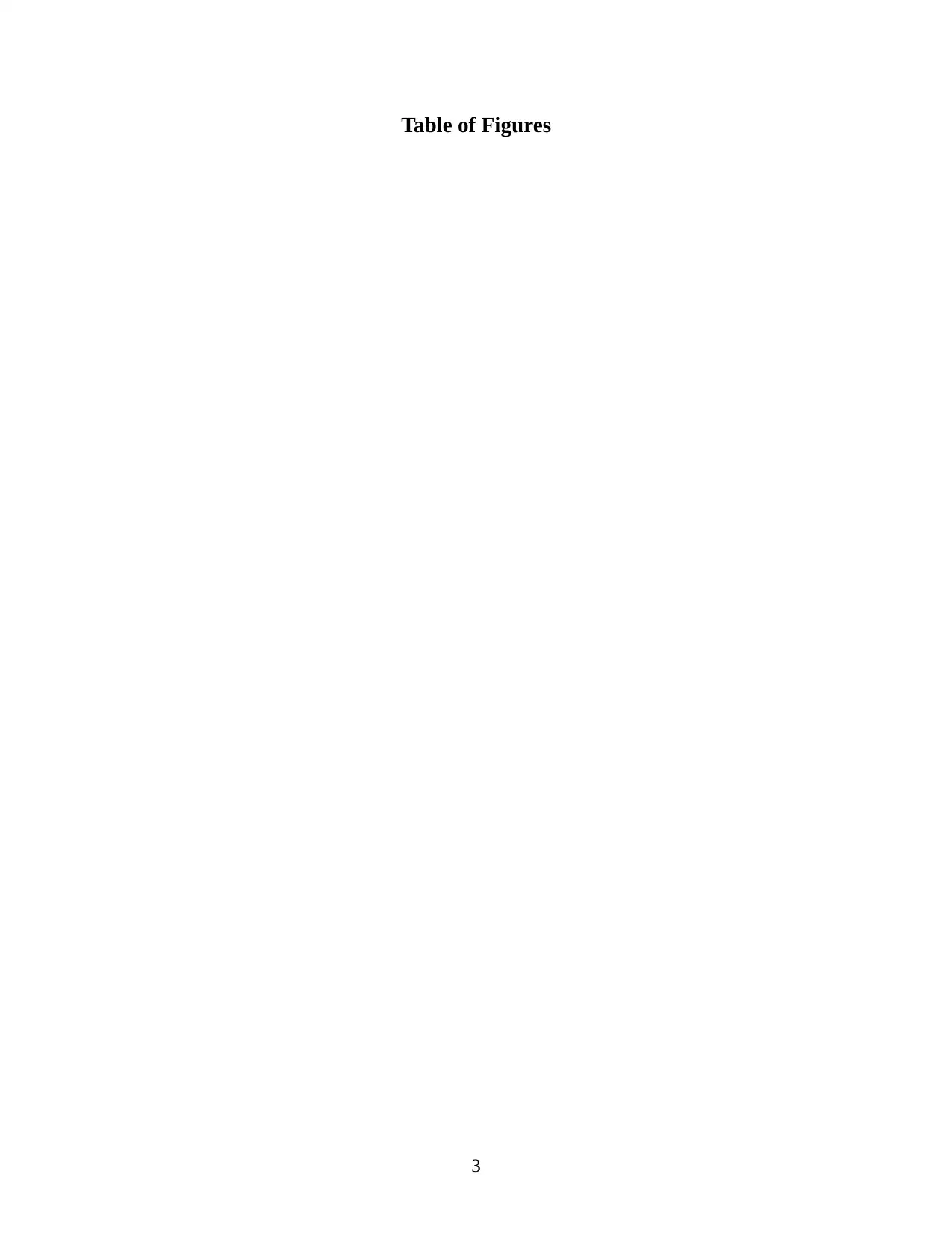
Table of Figures
3
3
⊘ This is a preview!⊘
Do you want full access?
Subscribe today to unlock all pages.

Trusted by 1+ million students worldwide
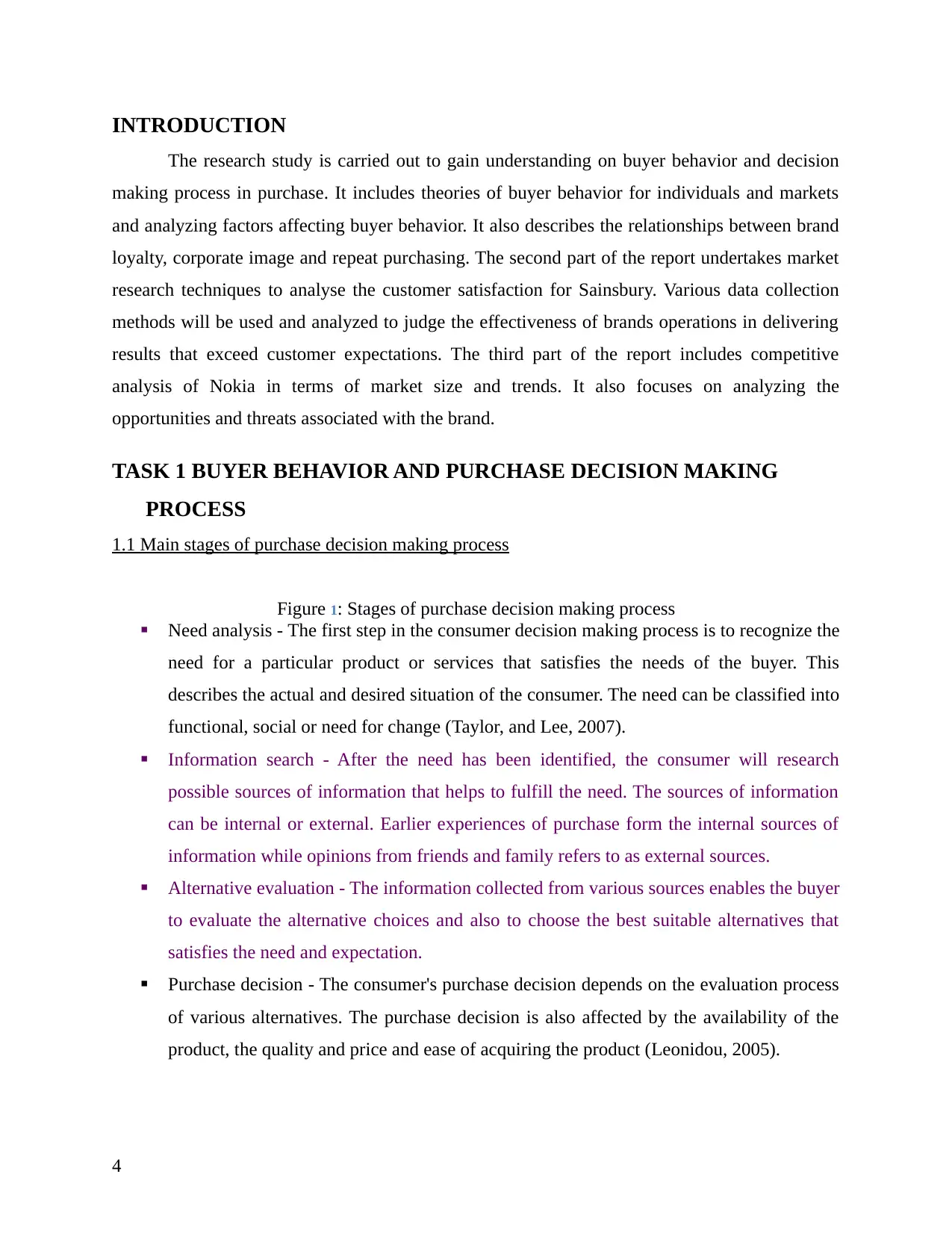
INTRODUCTION
The research study is carried out to gain understanding on buyer behavior and decision
making process in purchase. It includes theories of buyer behavior for individuals and markets
and analyzing factors affecting buyer behavior. It also describes the relationships between brand
loyalty, corporate image and repeat purchasing. The second part of the report undertakes market
research techniques to analyse the customer satisfaction for Sainsbury. Various data collection
methods will be used and analyzed to judge the effectiveness of brands operations in delivering
results that exceed customer expectations. The third part of the report includes competitive
analysis of Nokia in terms of market size and trends. It also focuses on analyzing the
opportunities and threats associated with the brand.
TASK 1 BUYER BEHAVIOR AND PURCHASE DECISION MAKING
PROCESS
1.1 Main stages of purchase decision making process
Figure 1: Stages of purchase decision making process
Need analysis - The first step in the consumer decision making process is to recognize the
need for a particular product or services that satisfies the needs of the buyer. This
describes the actual and desired situation of the consumer. The need can be classified into
functional, social or need for change (Taylor, and Lee, 2007).
Information search - After the need has been identified, the consumer will research
possible sources of information that helps to fulfill the need. The sources of information
can be internal or external. Earlier experiences of purchase form the internal sources of
information while opinions from friends and family refers to as external sources.
Alternative evaluation - The information collected from various sources enables the buyer
to evaluate the alternative choices and also to choose the best suitable alternatives that
satisfies the need and expectation.
Purchase decision - The consumer's purchase decision depends on the evaluation process
of various alternatives. The purchase decision is also affected by the availability of the
product, the quality and price and ease of acquiring the product (Leonidou, 2005).
4
The research study is carried out to gain understanding on buyer behavior and decision
making process in purchase. It includes theories of buyer behavior for individuals and markets
and analyzing factors affecting buyer behavior. It also describes the relationships between brand
loyalty, corporate image and repeat purchasing. The second part of the report undertakes market
research techniques to analyse the customer satisfaction for Sainsbury. Various data collection
methods will be used and analyzed to judge the effectiveness of brands operations in delivering
results that exceed customer expectations. The third part of the report includes competitive
analysis of Nokia in terms of market size and trends. It also focuses on analyzing the
opportunities and threats associated with the brand.
TASK 1 BUYER BEHAVIOR AND PURCHASE DECISION MAKING
PROCESS
1.1 Main stages of purchase decision making process
Figure 1: Stages of purchase decision making process
Need analysis - The first step in the consumer decision making process is to recognize the
need for a particular product or services that satisfies the needs of the buyer. This
describes the actual and desired situation of the consumer. The need can be classified into
functional, social or need for change (Taylor, and Lee, 2007).
Information search - After the need has been identified, the consumer will research
possible sources of information that helps to fulfill the need. The sources of information
can be internal or external. Earlier experiences of purchase form the internal sources of
information while opinions from friends and family refers to as external sources.
Alternative evaluation - The information collected from various sources enables the buyer
to evaluate the alternative choices and also to choose the best suitable alternatives that
satisfies the need and expectation.
Purchase decision - The consumer's purchase decision depends on the evaluation process
of various alternatives. The purchase decision is also affected by the availability of the
product, the quality and price and ease of acquiring the product (Leonidou, 2005).
4
Paraphrase This Document
Need a fresh take? Get an instant paraphrase of this document with our AI Paraphraser
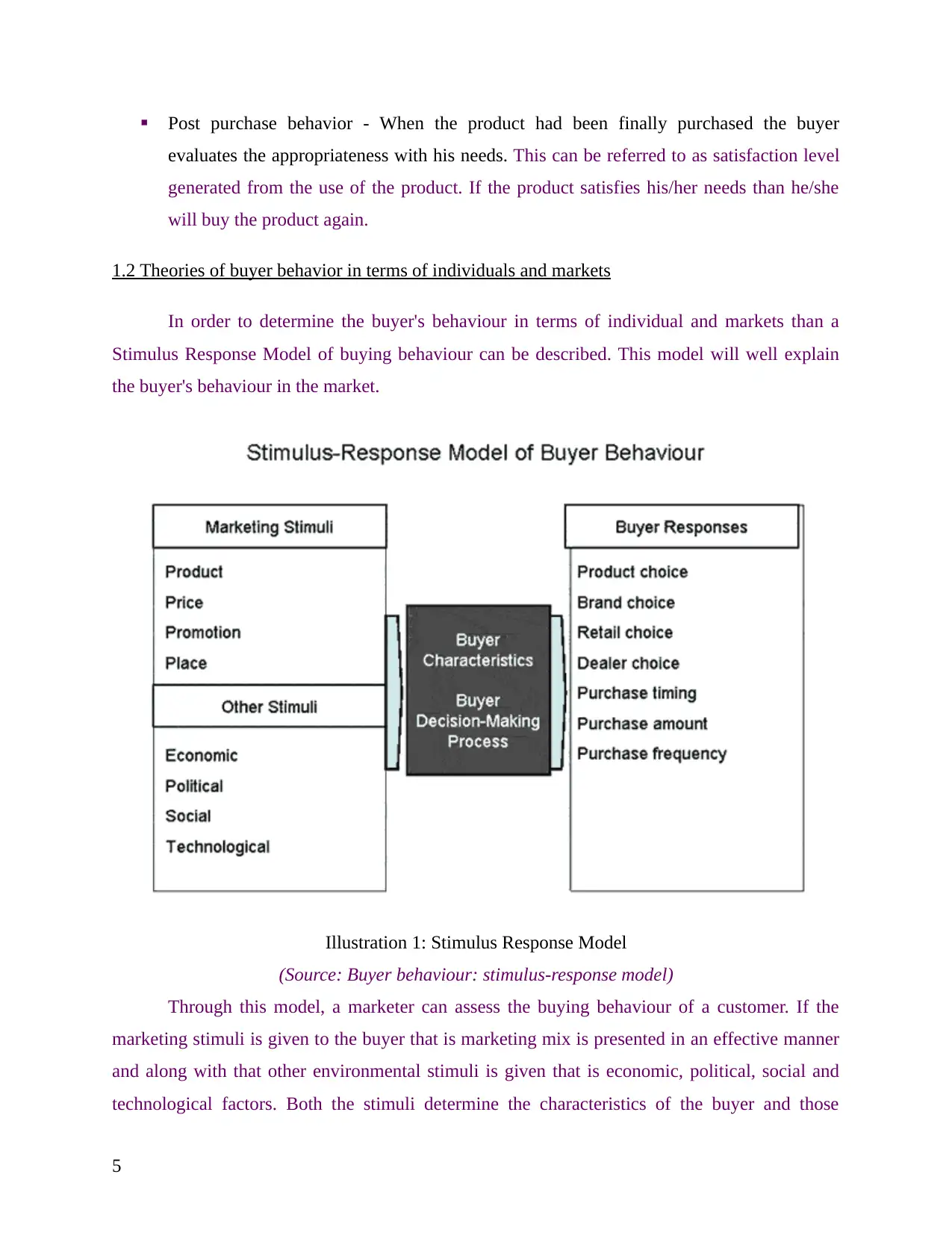
Post purchase behavior - When the product had been finally purchased the buyer
evaluates the appropriateness with his needs. This can be referred to as satisfaction level
generated from the use of the product. If the product satisfies his/her needs than he/she
will buy the product again.
1.2 Theories of buyer behavior in terms of individuals and markets
In order to determine the buyer's behaviour in terms of individual and markets than a
Stimulus Response Model of buying behaviour can be described. This model will well explain
the buyer's behaviour in the market.
(Source: Buyer behaviour: stimulus-response model)
Through this model, a marketer can assess the buying behaviour of a customer. If the
marketing stimuli is given to the buyer that is marketing mix is presented in an effective manner
and along with that other environmental stimuli is given that is economic, political, social and
technological factors. Both the stimuli determine the characteristics of the buyer and those
5
Illustration 1: Stimulus Response Model
evaluates the appropriateness with his needs. This can be referred to as satisfaction level
generated from the use of the product. If the product satisfies his/her needs than he/she
will buy the product again.
1.2 Theories of buyer behavior in terms of individuals and markets
In order to determine the buyer's behaviour in terms of individual and markets than a
Stimulus Response Model of buying behaviour can be described. This model will well explain
the buyer's behaviour in the market.
(Source: Buyer behaviour: stimulus-response model)
Through this model, a marketer can assess the buying behaviour of a customer. If the
marketing stimuli is given to the buyer that is marketing mix is presented in an effective manner
and along with that other environmental stimuli is given that is economic, political, social and
technological factors. Both the stimuli determine the characteristics of the buyer and those
5
Illustration 1: Stimulus Response Model
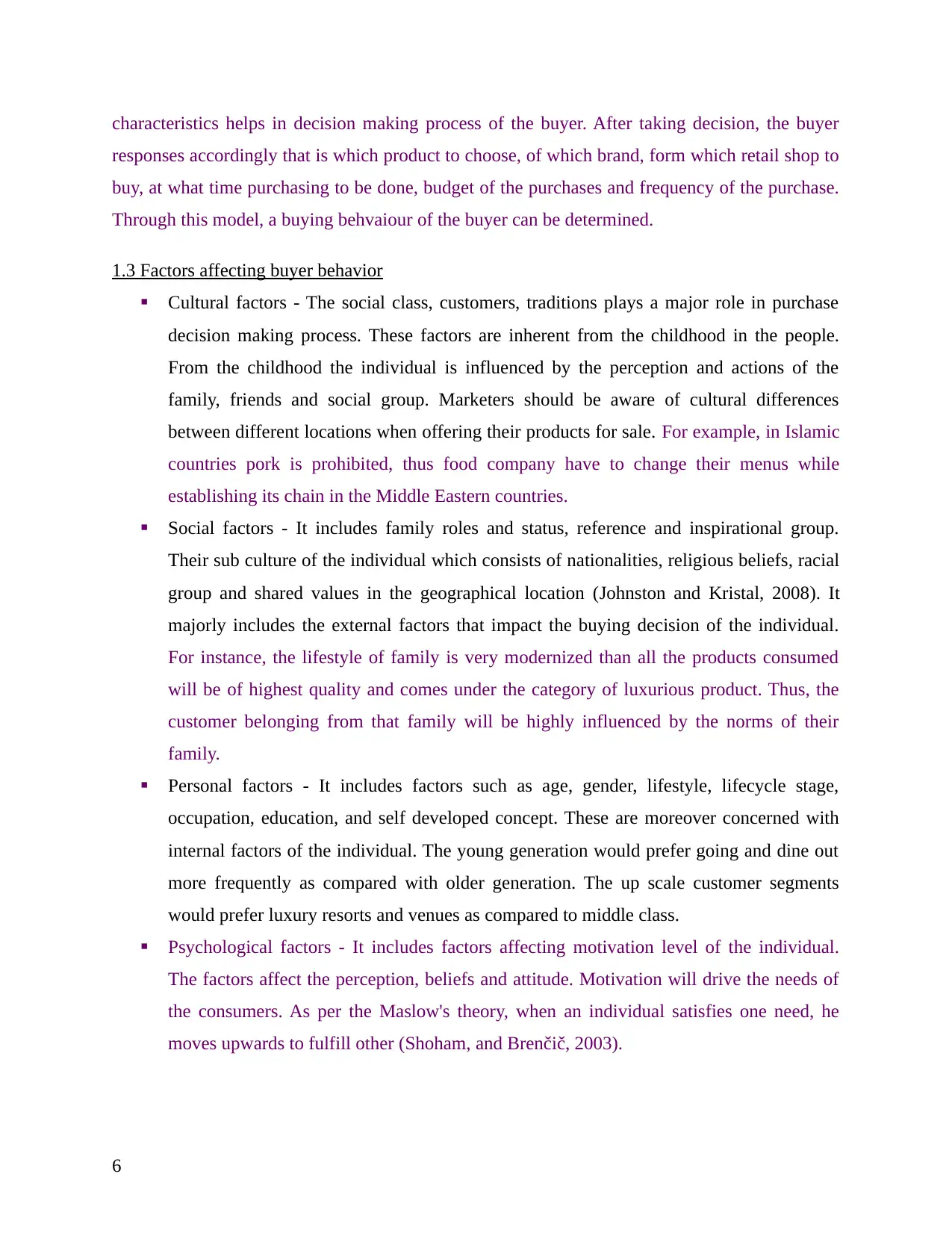
characteristics helps in decision making process of the buyer. After taking decision, the buyer
responses accordingly that is which product to choose, of which brand, form which retail shop to
buy, at what time purchasing to be done, budget of the purchases and frequency of the purchase.
Through this model, a buying behvaiour of the buyer can be determined.
1.3 Factors affecting buyer behavior
Cultural factors - The social class, customers, traditions plays a major role in purchase
decision making process. These factors are inherent from the childhood in the people.
From the childhood the individual is influenced by the perception and actions of the
family, friends and social group. Marketers should be aware of cultural differences
between different locations when offering their products for sale. For example, in Islamic
countries pork is prohibited, thus food company have to change their menus while
establishing its chain in the Middle Eastern countries.
Social factors - It includes family roles and status, reference and inspirational group.
Their sub culture of the individual which consists of nationalities, religious beliefs, racial
group and shared values in the geographical location (Johnston and Kristal, 2008). It
majorly includes the external factors that impact the buying decision of the individual.
For instance, the lifestyle of family is very modernized than all the products consumed
will be of highest quality and comes under the category of luxurious product. Thus, the
customer belonging from that family will be highly influenced by the norms of their
family.
Personal factors - It includes factors such as age, gender, lifestyle, lifecycle stage,
occupation, education, and self developed concept. These are moreover concerned with
internal factors of the individual. The young generation would prefer going and dine out
more frequently as compared with older generation. The up scale customer segments
would prefer luxury resorts and venues as compared to middle class.
Psychological factors - It includes factors affecting motivation level of the individual.
The factors affect the perception, beliefs and attitude. Motivation will drive the needs of
the consumers. As per the Maslow's theory, when an individual satisfies one need, he
moves upwards to fulfill other (Shoham, and Brenčič, 2003).
6
responses accordingly that is which product to choose, of which brand, form which retail shop to
buy, at what time purchasing to be done, budget of the purchases and frequency of the purchase.
Through this model, a buying behvaiour of the buyer can be determined.
1.3 Factors affecting buyer behavior
Cultural factors - The social class, customers, traditions plays a major role in purchase
decision making process. These factors are inherent from the childhood in the people.
From the childhood the individual is influenced by the perception and actions of the
family, friends and social group. Marketers should be aware of cultural differences
between different locations when offering their products for sale. For example, in Islamic
countries pork is prohibited, thus food company have to change their menus while
establishing its chain in the Middle Eastern countries.
Social factors - It includes family roles and status, reference and inspirational group.
Their sub culture of the individual which consists of nationalities, religious beliefs, racial
group and shared values in the geographical location (Johnston and Kristal, 2008). It
majorly includes the external factors that impact the buying decision of the individual.
For instance, the lifestyle of family is very modernized than all the products consumed
will be of highest quality and comes under the category of luxurious product. Thus, the
customer belonging from that family will be highly influenced by the norms of their
family.
Personal factors - It includes factors such as age, gender, lifestyle, lifecycle stage,
occupation, education, and self developed concept. These are moreover concerned with
internal factors of the individual. The young generation would prefer going and dine out
more frequently as compared with older generation. The up scale customer segments
would prefer luxury resorts and venues as compared to middle class.
Psychological factors - It includes factors affecting motivation level of the individual.
The factors affect the perception, beliefs and attitude. Motivation will drive the needs of
the consumers. As per the Maslow's theory, when an individual satisfies one need, he
moves upwards to fulfill other (Shoham, and Brenčič, 2003).
6
⊘ This is a preview!⊘
Do you want full access?
Subscribe today to unlock all pages.

Trusted by 1+ million students worldwide
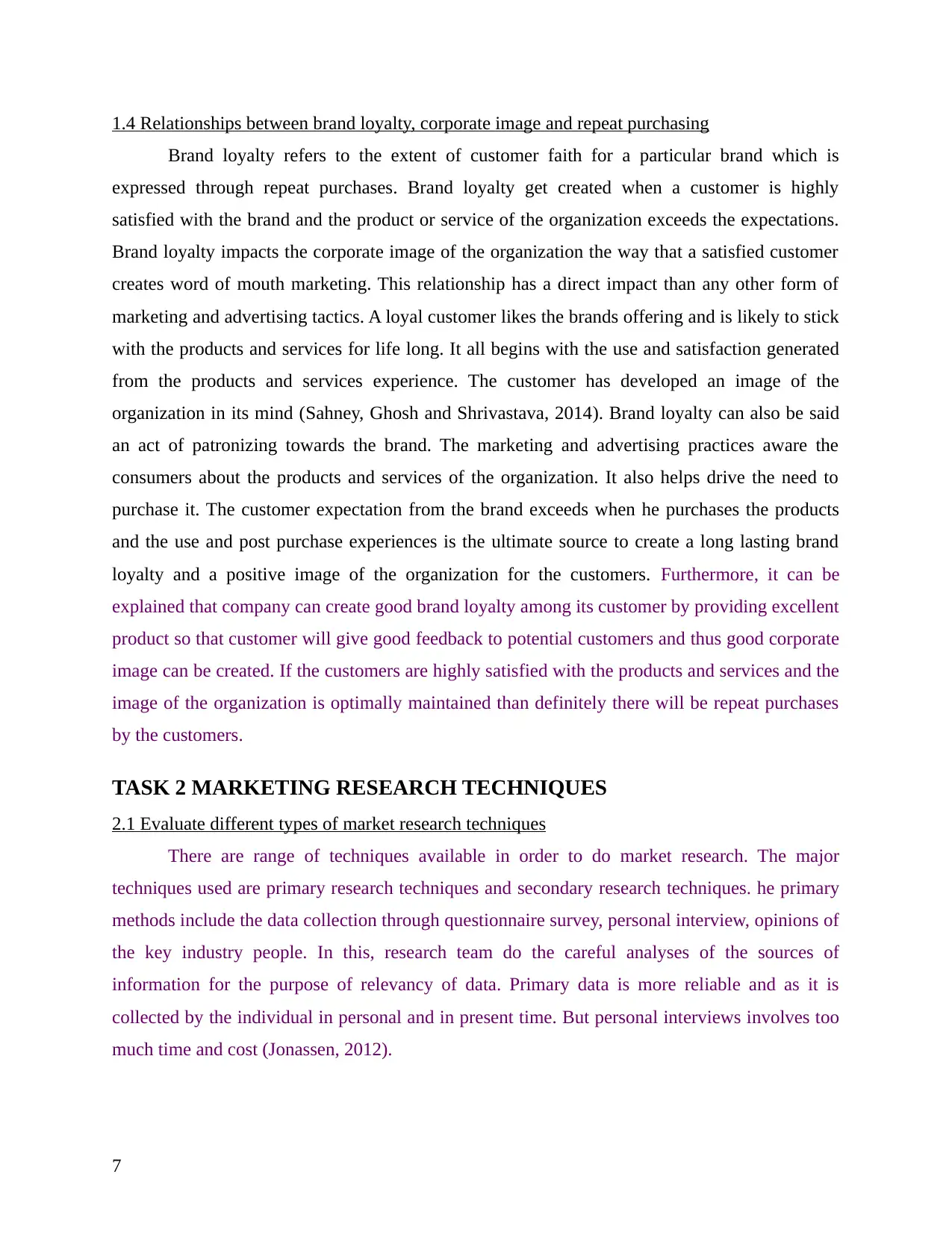
1.4 Relationships between brand loyalty, corporate image and repeat purchasing
Brand loyalty refers to the extent of customer faith for a particular brand which is
expressed through repeat purchases. Brand loyalty get created when a customer is highly
satisfied with the brand and the product or service of the organization exceeds the expectations.
Brand loyalty impacts the corporate image of the organization the way that a satisfied customer
creates word of mouth marketing. This relationship has a direct impact than any other form of
marketing and advertising tactics. A loyal customer likes the brands offering and is likely to stick
with the products and services for life long. It all begins with the use and satisfaction generated
from the products and services experience. The customer has developed an image of the
organization in its mind (Sahney, Ghosh and Shrivastava, 2014). Brand loyalty can also be said
an act of patronizing towards the brand. The marketing and advertising practices aware the
consumers about the products and services of the organization. It also helps drive the need to
purchase it. The customer expectation from the brand exceeds when he purchases the products
and the use and post purchase experiences is the ultimate source to create a long lasting brand
loyalty and a positive image of the organization for the customers. Furthermore, it can be
explained that company can create good brand loyalty among its customer by providing excellent
product so that customer will give good feedback to potential customers and thus good corporate
image can be created. If the customers are highly satisfied with the products and services and the
image of the organization is optimally maintained than definitely there will be repeat purchases
by the customers.
TASK 2 MARKETING RESEARCH TECHNIQUES
2.1 Evaluate different types of market research techniques
There are range of techniques available in order to do market research. The major
techniques used are primary research techniques and secondary research techniques. he primary
methods include the data collection through questionnaire survey, personal interview, opinions of
the key industry people. In this, research team do the careful analyses of the sources of
information for the purpose of relevancy of data. Primary data is more reliable and as it is
collected by the individual in personal and in present time. But personal interviews involves too
much time and cost (Jonassen, 2012).
7
Brand loyalty refers to the extent of customer faith for a particular brand which is
expressed through repeat purchases. Brand loyalty get created when a customer is highly
satisfied with the brand and the product or service of the organization exceeds the expectations.
Brand loyalty impacts the corporate image of the organization the way that a satisfied customer
creates word of mouth marketing. This relationship has a direct impact than any other form of
marketing and advertising tactics. A loyal customer likes the brands offering and is likely to stick
with the products and services for life long. It all begins with the use and satisfaction generated
from the products and services experience. The customer has developed an image of the
organization in its mind (Sahney, Ghosh and Shrivastava, 2014). Brand loyalty can also be said
an act of patronizing towards the brand. The marketing and advertising practices aware the
consumers about the products and services of the organization. It also helps drive the need to
purchase it. The customer expectation from the brand exceeds when he purchases the products
and the use and post purchase experiences is the ultimate source to create a long lasting brand
loyalty and a positive image of the organization for the customers. Furthermore, it can be
explained that company can create good brand loyalty among its customer by providing excellent
product so that customer will give good feedback to potential customers and thus good corporate
image can be created. If the customers are highly satisfied with the products and services and the
image of the organization is optimally maintained than definitely there will be repeat purchases
by the customers.
TASK 2 MARKETING RESEARCH TECHNIQUES
2.1 Evaluate different types of market research techniques
There are range of techniques available in order to do market research. The major
techniques used are primary research techniques and secondary research techniques. he primary
methods include the data collection through questionnaire survey, personal interview, opinions of
the key industry people. In this, research team do the careful analyses of the sources of
information for the purpose of relevancy of data. Primary data is more reliable and as it is
collected by the individual in personal and in present time. But personal interviews involves too
much time and cost (Jonassen, 2012).
7
Paraphrase This Document
Need a fresh take? Get an instant paraphrase of this document with our AI Paraphraser
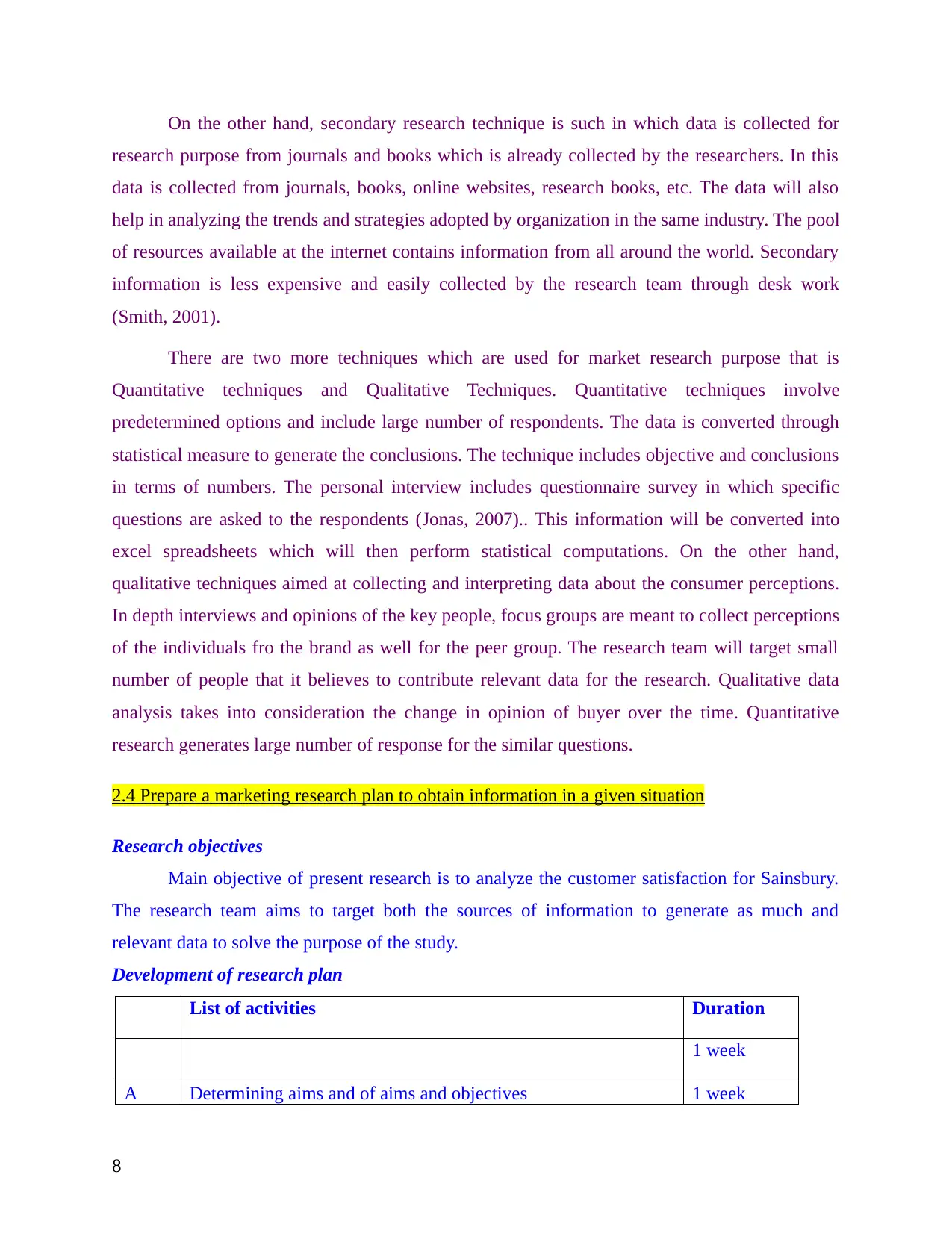
On the other hand, secondary research technique is such in which data is collected for
research purpose from journals and books which is already collected by the researchers. In this
data is collected from journals, books, online websites, research books, etc. The data will also
help in analyzing the trends and strategies adopted by organization in the same industry. The pool
of resources available at the internet contains information from all around the world. Secondary
information is less expensive and easily collected by the research team through desk work
(Smith, 2001).
There are two more techniques which are used for market research purpose that is
Quantitative techniques and Qualitative Techniques. Quantitative techniques involve
predetermined options and include large number of respondents. The data is converted through
statistical measure to generate the conclusions. The technique includes objective and conclusions
in terms of numbers. The personal interview includes questionnaire survey in which specific
questions are asked to the respondents (Jonas, 2007).. This information will be converted into
excel spreadsheets which will then perform statistical computations. On the other hand,
qualitative techniques aimed at collecting and interpreting data about the consumer perceptions.
In depth interviews and opinions of the key people, focus groups are meant to collect perceptions
of the individuals fro the brand as well for the peer group. The research team will target small
number of people that it believes to contribute relevant data for the research. Qualitative data
analysis takes into consideration the change in opinion of buyer over the time. Quantitative
research generates large number of response for the similar questions.
2.4 Prepare a marketing research plan to obtain information in a given situation
Research objectives
Main objective of present research is to analyze the customer satisfaction for Sainsbury.
The research team aims to target both the sources of information to generate as much and
relevant data to solve the purpose of the study.
Development of research plan
List of activities Duration
1 week
A Determining aims and of aims and objectives 1 week
8
research purpose from journals and books which is already collected by the researchers. In this
data is collected from journals, books, online websites, research books, etc. The data will also
help in analyzing the trends and strategies adopted by organization in the same industry. The pool
of resources available at the internet contains information from all around the world. Secondary
information is less expensive and easily collected by the research team through desk work
(Smith, 2001).
There are two more techniques which are used for market research purpose that is
Quantitative techniques and Qualitative Techniques. Quantitative techniques involve
predetermined options and include large number of respondents. The data is converted through
statistical measure to generate the conclusions. The technique includes objective and conclusions
in terms of numbers. The personal interview includes questionnaire survey in which specific
questions are asked to the respondents (Jonas, 2007).. This information will be converted into
excel spreadsheets which will then perform statistical computations. On the other hand,
qualitative techniques aimed at collecting and interpreting data about the consumer perceptions.
In depth interviews and opinions of the key people, focus groups are meant to collect perceptions
of the individuals fro the brand as well for the peer group. The research team will target small
number of people that it believes to contribute relevant data for the research. Qualitative data
analysis takes into consideration the change in opinion of buyer over the time. Quantitative
research generates large number of response for the similar questions.
2.4 Prepare a marketing research plan to obtain information in a given situation
Research objectives
Main objective of present research is to analyze the customer satisfaction for Sainsbury.
The research team aims to target both the sources of information to generate as much and
relevant data to solve the purpose of the study.
Development of research plan
List of activities Duration
1 week
A Determining aims and of aims and objectives 1 week
8
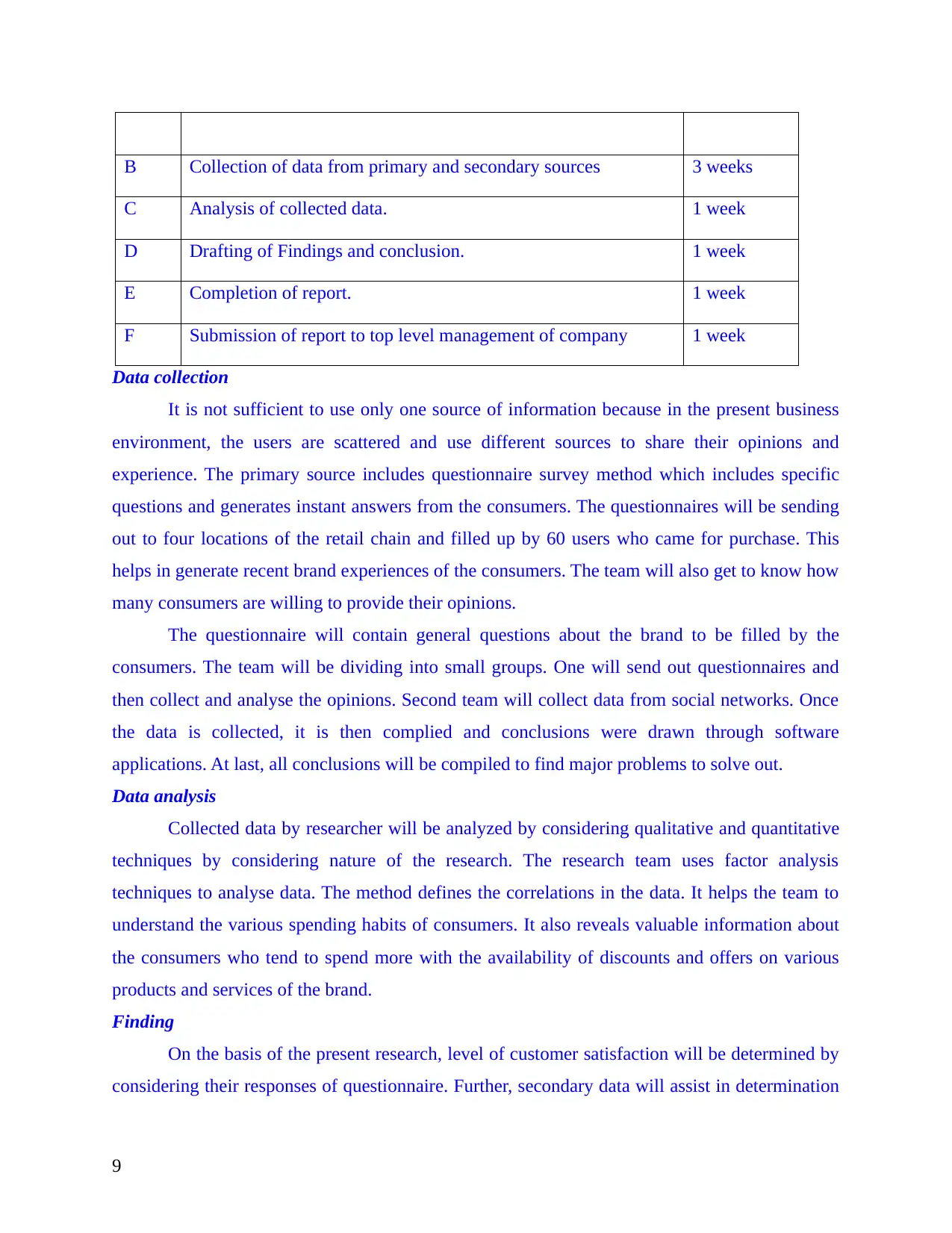
B Collection of data from primary and secondary sources 3 weeks
C Analysis of collected data. 1 week
D Drafting of Findings and conclusion. 1 week
E Completion of report. 1 week
F Submission of report to top level management of company 1 week
Data collection
It is not sufficient to use only one source of information because in the present business
environment, the users are scattered and use different sources to share their opinions and
experience. The primary source includes questionnaire survey method which includes specific
questions and generates instant answers from the consumers. The questionnaires will be sending
out to four locations of the retail chain and filled up by 60 users who came for purchase. This
helps in generate recent brand experiences of the consumers. The team will also get to know how
many consumers are willing to provide their opinions.
The questionnaire will contain general questions about the brand to be filled by the
consumers. The team will be dividing into small groups. One will send out questionnaires and
then collect and analyse the opinions. Second team will collect data from social networks. Once
the data is collected, it is then complied and conclusions were drawn through software
applications. At last, all conclusions will be compiled to find major problems to solve out.
Data analysis
Collected data by researcher will be analyzed by considering qualitative and quantitative
techniques by considering nature of the research. The research team uses factor analysis
techniques to analyse data. The method defines the correlations in the data. It helps the team to
understand the various spending habits of consumers. It also reveals valuable information about
the consumers who tend to spend more with the availability of discounts and offers on various
products and services of the brand.
Finding
On the basis of the present research, level of customer satisfaction will be determined by
considering their responses of questionnaire. Further, secondary data will assist in determination
9
C Analysis of collected data. 1 week
D Drafting of Findings and conclusion. 1 week
E Completion of report. 1 week
F Submission of report to top level management of company 1 week
Data collection
It is not sufficient to use only one source of information because in the present business
environment, the users are scattered and use different sources to share their opinions and
experience. The primary source includes questionnaire survey method which includes specific
questions and generates instant answers from the consumers. The questionnaires will be sending
out to four locations of the retail chain and filled up by 60 users who came for purchase. This
helps in generate recent brand experiences of the consumers. The team will also get to know how
many consumers are willing to provide their opinions.
The questionnaire will contain general questions about the brand to be filled by the
consumers. The team will be dividing into small groups. One will send out questionnaires and
then collect and analyse the opinions. Second team will collect data from social networks. Once
the data is collected, it is then complied and conclusions were drawn through software
applications. At last, all conclusions will be compiled to find major problems to solve out.
Data analysis
Collected data by researcher will be analyzed by considering qualitative and quantitative
techniques by considering nature of the research. The research team uses factor analysis
techniques to analyse data. The method defines the correlations in the data. It helps the team to
understand the various spending habits of consumers. It also reveals valuable information about
the consumers who tend to spend more with the availability of discounts and offers on various
products and services of the brand.
Finding
On the basis of the present research, level of customer satisfaction will be determined by
considering their responses of questionnaire. Further, secondary data will assist in determination
9
⊘ This is a preview!⊘
Do you want full access?
Subscribe today to unlock all pages.

Trusted by 1+ million students worldwide
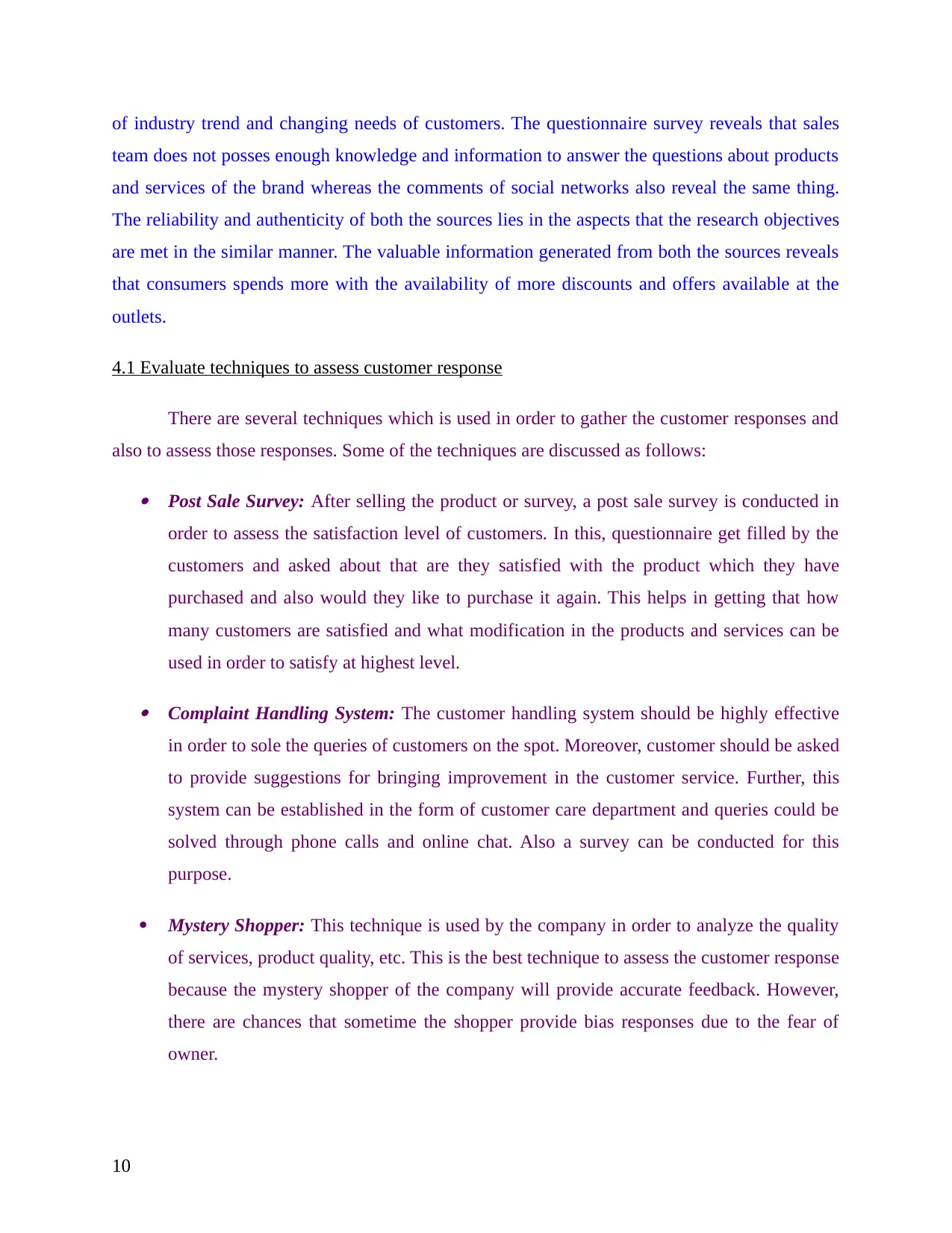
of industry trend and changing needs of customers. The questionnaire survey reveals that sales
team does not posses enough knowledge and information to answer the questions about products
and services of the brand whereas the comments of social networks also reveal the same thing.
The reliability and authenticity of both the sources lies in the aspects that the research objectives
are met in the similar manner. The valuable information generated from both the sources reveals
that consumers spends more with the availability of more discounts and offers available at the
outlets.
4.1 Evaluate techniques to assess customer response
There are several techniques which is used in order to gather the customer responses and
also to assess those responses. Some of the techniques are discussed as follows:
Post Sale Survey: After selling the product or survey, a post sale survey is conducted in
order to assess the satisfaction level of customers. In this, questionnaire get filled by the
customers and asked about that are they satisfied with the product which they have
purchased and also would they like to purchase it again. This helps in getting that how
many customers are satisfied and what modification in the products and services can be
used in order to satisfy at highest level.
Complaint Handling System: The customer handling system should be highly effective
in order to sole the queries of customers on the spot. Moreover, customer should be asked
to provide suggestions for bringing improvement in the customer service. Further, this
system can be established in the form of customer care department and queries could be
solved through phone calls and online chat. Also a survey can be conducted for this
purpose.
Mystery Shopper: This technique is used by the company in order to analyze the quality
of services, product quality, etc. This is the best technique to assess the customer response
because the mystery shopper of the company will provide accurate feedback. However,
there are chances that sometime the shopper provide bias responses due to the fear of
owner.
10
team does not posses enough knowledge and information to answer the questions about products
and services of the brand whereas the comments of social networks also reveal the same thing.
The reliability and authenticity of both the sources lies in the aspects that the research objectives
are met in the similar manner. The valuable information generated from both the sources reveals
that consumers spends more with the availability of more discounts and offers available at the
outlets.
4.1 Evaluate techniques to assess customer response
There are several techniques which is used in order to gather the customer responses and
also to assess those responses. Some of the techniques are discussed as follows:
Post Sale Survey: After selling the product or survey, a post sale survey is conducted in
order to assess the satisfaction level of customers. In this, questionnaire get filled by the
customers and asked about that are they satisfied with the product which they have
purchased and also would they like to purchase it again. This helps in getting that how
many customers are satisfied and what modification in the products and services can be
used in order to satisfy at highest level.
Complaint Handling System: The customer handling system should be highly effective
in order to sole the queries of customers on the spot. Moreover, customer should be asked
to provide suggestions for bringing improvement in the customer service. Further, this
system can be established in the form of customer care department and queries could be
solved through phone calls and online chat. Also a survey can be conducted for this
purpose.
Mystery Shopper: This technique is used by the company in order to analyze the quality
of services, product quality, etc. This is the best technique to assess the customer response
because the mystery shopper of the company will provide accurate feedback. However,
there are chances that sometime the shopper provide bias responses due to the fear of
owner.
10
Paraphrase This Document
Need a fresh take? Get an instant paraphrase of this document with our AI Paraphraser
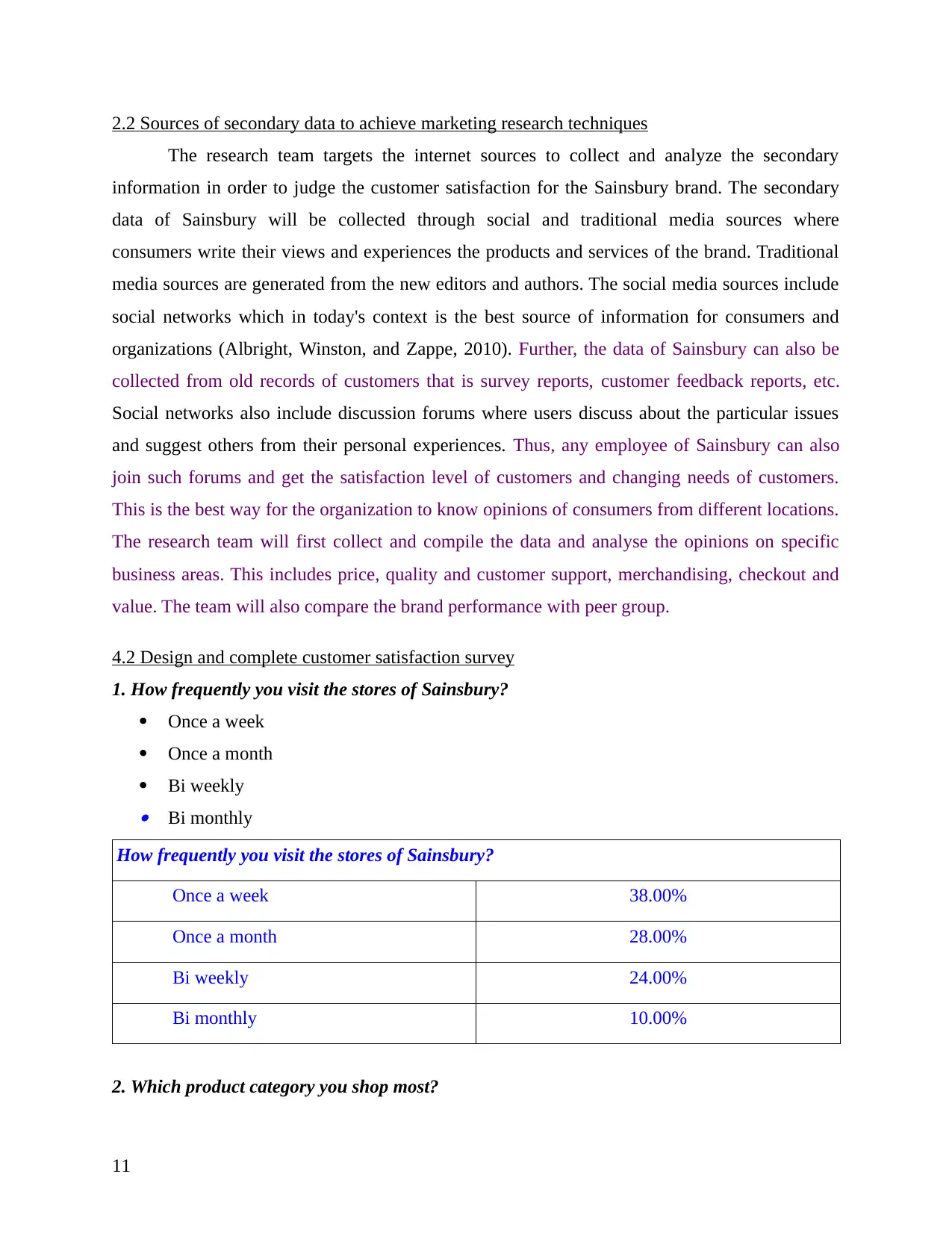
2.2 Sources of secondary data to achieve marketing research techniques
The research team targets the internet sources to collect and analyze the secondary
information in order to judge the customer satisfaction for the Sainsbury brand. The secondary
data of Sainsbury will be collected through social and traditional media sources where
consumers write their views and experiences the products and services of the brand. Traditional
media sources are generated from the new editors and authors. The social media sources include
social networks which in today's context is the best source of information for consumers and
organizations (Albright, Winston, and Zappe, 2010). Further, the data of Sainsbury can also be
collected from old records of customers that is survey reports, customer feedback reports, etc.
Social networks also include discussion forums where users discuss about the particular issues
and suggest others from their personal experiences. Thus, any employee of Sainsbury can also
join such forums and get the satisfaction level of customers and changing needs of customers.
This is the best way for the organization to know opinions of consumers from different locations.
The research team will first collect and compile the data and analyse the opinions on specific
business areas. This includes price, quality and customer support, merchandising, checkout and
value. The team will also compare the brand performance with peer group.
4.2 Design and complete customer satisfaction survey
1. How frequently you visit the stores of Sainsbury?
Once a week
Once a month
Bi weekly Bi monthly
How frequently you visit the stores of Sainsbury?
Once a week 38.00%
Once a month 28.00%
Bi weekly 24.00%
Bi monthly 10.00%
2. Which product category you shop most?
11
The research team targets the internet sources to collect and analyze the secondary
information in order to judge the customer satisfaction for the Sainsbury brand. The secondary
data of Sainsbury will be collected through social and traditional media sources where
consumers write their views and experiences the products and services of the brand. Traditional
media sources are generated from the new editors and authors. The social media sources include
social networks which in today's context is the best source of information for consumers and
organizations (Albright, Winston, and Zappe, 2010). Further, the data of Sainsbury can also be
collected from old records of customers that is survey reports, customer feedback reports, etc.
Social networks also include discussion forums where users discuss about the particular issues
and suggest others from their personal experiences. Thus, any employee of Sainsbury can also
join such forums and get the satisfaction level of customers and changing needs of customers.
This is the best way for the organization to know opinions of consumers from different locations.
The research team will first collect and compile the data and analyse the opinions on specific
business areas. This includes price, quality and customer support, merchandising, checkout and
value. The team will also compare the brand performance with peer group.
4.2 Design and complete customer satisfaction survey
1. How frequently you visit the stores of Sainsbury?
Once a week
Once a month
Bi weekly Bi monthly
How frequently you visit the stores of Sainsbury?
Once a week 38.00%
Once a month 28.00%
Bi weekly 24.00%
Bi monthly 10.00%
2. Which product category you shop most?
11
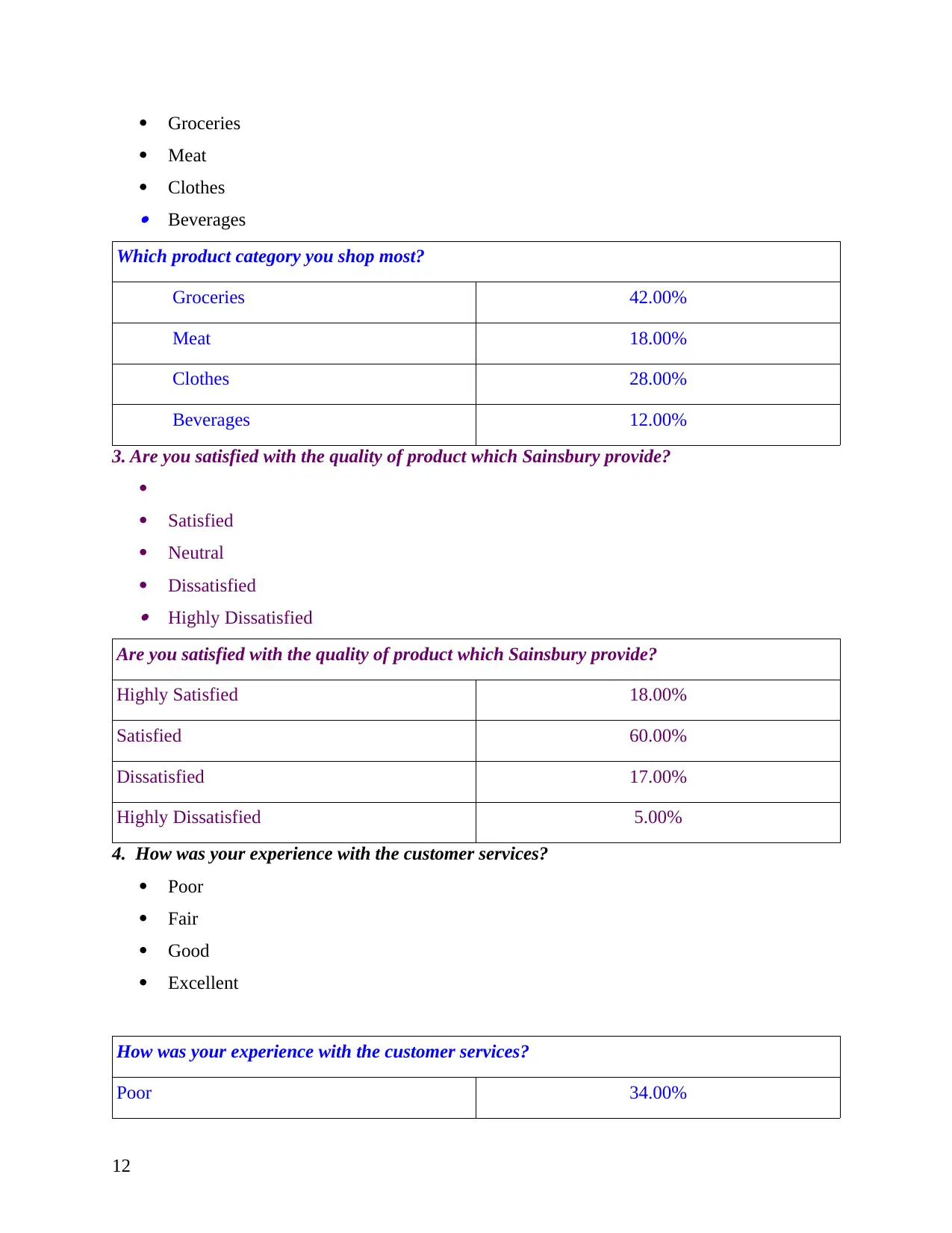
Groceries
Meat
Clothes Beverages
Which product category you shop most?
Groceries 42.00%
Meat 18.00%
Clothes 28.00%
Beverages 12.00%
3. Are you satisfied with the quality of product which Sainsbury provide?
Satisfied
Neutral
Dissatisfied Highly Dissatisfied
Are you satisfied with the quality of product which Sainsbury provide?
Highly Satisfied 18.00%
Satisfied 60.00%
Dissatisfied 17.00%
Highly Dissatisfied 5.00%
4. How was your experience with the customer services?
Poor
Fair
Good
Excellent
How was your experience with the customer services?
Poor 34.00%
12
Meat
Clothes Beverages
Which product category you shop most?
Groceries 42.00%
Meat 18.00%
Clothes 28.00%
Beverages 12.00%
3. Are you satisfied with the quality of product which Sainsbury provide?
Satisfied
Neutral
Dissatisfied Highly Dissatisfied
Are you satisfied with the quality of product which Sainsbury provide?
Highly Satisfied 18.00%
Satisfied 60.00%
Dissatisfied 17.00%
Highly Dissatisfied 5.00%
4. How was your experience with the customer services?
Poor
Fair
Good
Excellent
How was your experience with the customer services?
Poor 34.00%
12
⊘ This is a preview!⊘
Do you want full access?
Subscribe today to unlock all pages.

Trusted by 1+ million students worldwide
1 out of 22
Related Documents
Your All-in-One AI-Powered Toolkit for Academic Success.
+13062052269
info@desklib.com
Available 24*7 on WhatsApp / Email
![[object Object]](/_next/static/media/star-bottom.7253800d.svg)
Unlock your academic potential
Copyright © 2020–2025 A2Z Services. All Rights Reserved. Developed and managed by ZUCOL.





